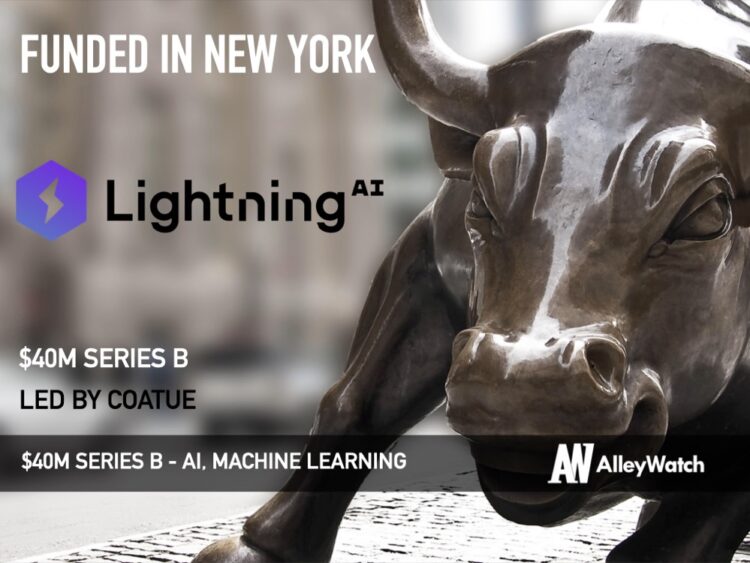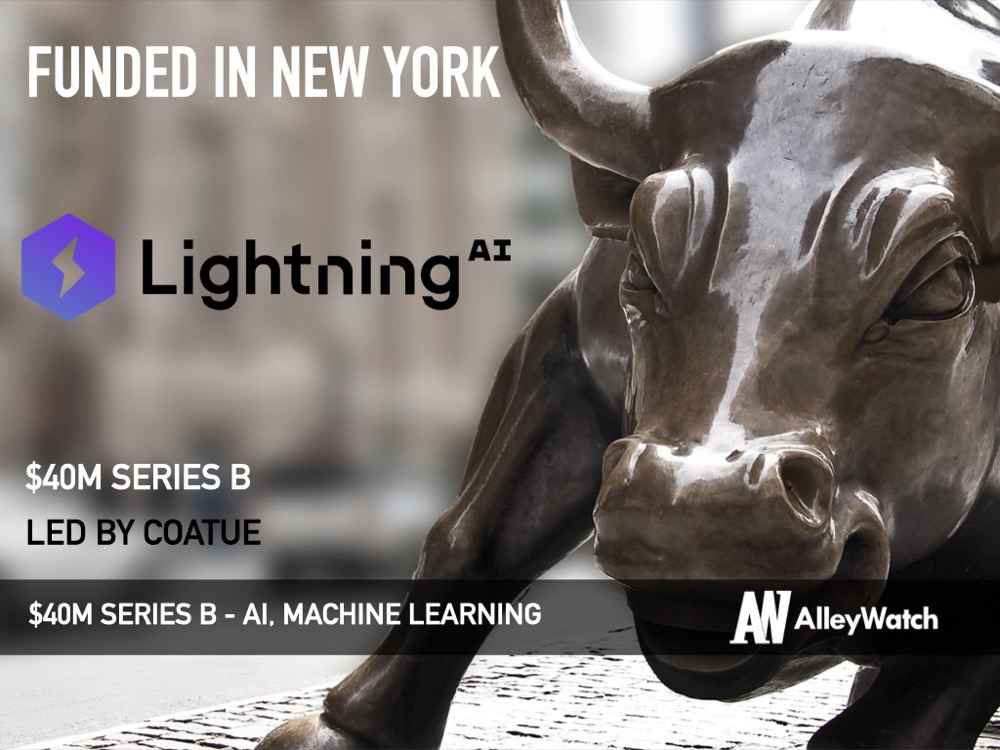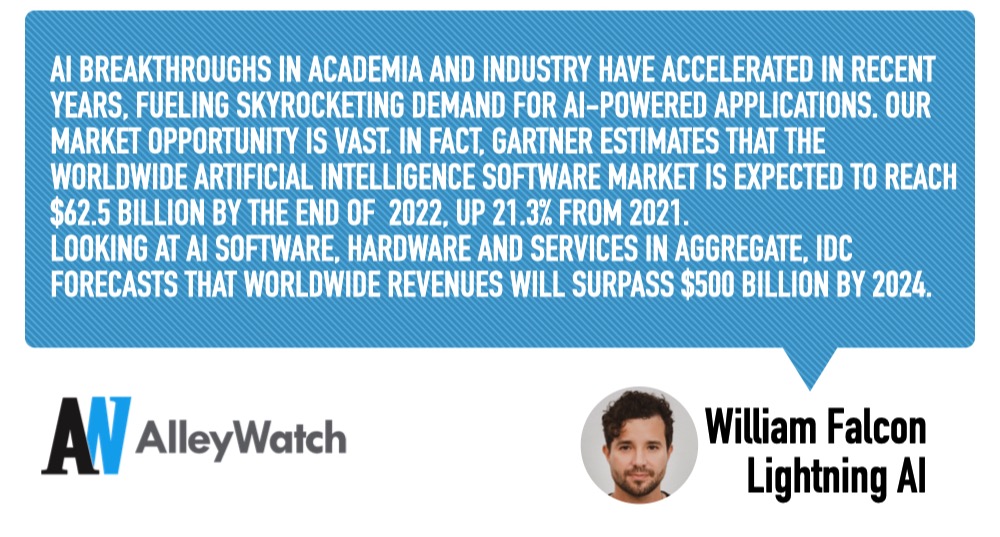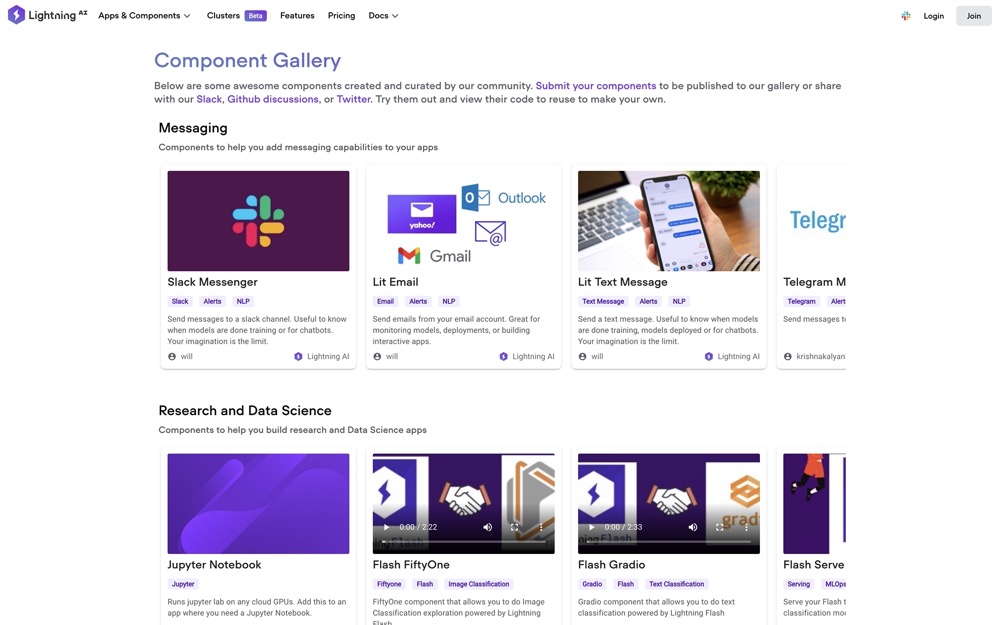Modular development focuses on separating the functionality of a program into independent building blocks that make up an executable application. WordPress and its near-endless repository of plugins is an example. Lightning AI, previously known as Grid AI, is a platform and framework that brings modular functionality for AI and Machine Learning. The platform allows anyone to quickly and seamlessly develop AI and ML workflows without deep technical knowledge, whether it be for production or for research. Projects developed using the Lightning framework can be hosted locally or on the cloud. The Lightning apps and components available for integration are all open-source, allowing users to customize based on their needs, saving valuable development time. Lightning AI is free to use for up to 20 total apps with paid plans offering more capabilities and usage.
AlleyWatch caught up with Lightning AI CEO and Cofounder William Falcon to learn more about the business, the company’s strategic plans, latest round of funding, which brings the total funding raised to $58.6M, and much, much more…
Who were your investors and how much did you raise?
Lightning AI raised a $40M Series B, led by Coatue, with participation from Index, Bain Capital Ventures, First Minute Capital, and the Chainsmokers’ Mantis VC.
Tell us about the product or service that Lightning AI offers.
Lightning AI enables researchers, data scientists, and software engineers to build, share and iterate on highly scalable, Lightning Apps (end-to-end ML systems) using the tools and technologies of their choice, regardless of their expertise. To solve any kind of AI problem from research projects to production-ready pipelines, users simply group the components of their choice into a Lightning App and customize the underlying code as needed. Lightning Apps can then be republished into the community for future use, or kept private in users’ personal libraries.
Lightning AI combines a wide variety of extant tools into a modular, intuitive platform for building Lightning Apps in research, enterprise, and personal contexts. It is the foundation of the growing Lightning ecosystem, which provides developers with a suite of ready-to-use tools and required infrastructure and compute resources, as well as community support for building Lightning Apps.
What inspired the start of Lightning AI?
 After I began developing the open-source deep learning framework PyTorch Lightning as an undergrad at Columbia in 2015, I founded Lightning AI (which was Grid.ai at the time) in 2019 with Luis Capelo. While working on my PhD at NYU and Facebook AI Research, I open-sourced PyTorch Lightning and it quickly gained traction as the tool of choice for AI researchers and ML engineers in industry working on state-of-the-art artificial intelligence projects.
After I began developing the open-source deep learning framework PyTorch Lightning as an undergrad at Columbia in 2015, I founded Lightning AI (which was Grid.ai at the time) in 2019 with Luis Capelo. While working on my PhD at NYU and Facebook AI Research, I open-sourced PyTorch Lightning and it quickly gained traction as the tool of choice for AI researchers and ML engineers in industry working on state-of-the-art artificial intelligence projects.
As companies in every industry began putting PyTorch Lightning into production, we realized that the biggest challenge holding back AI adoption at scale was fragmentation of the AI ecosystem. I first noticed the impact of the fragmented AI ecosystem back in 2019. Because AI adoption at scale was and still is so nascent, every few months we would discover a “missing” part of the machine learning stack. Things like feature stores and data versioning, for instance, appeared as key tools in 2019. The following year, in 2020, we discovered the need for experiment managers and the ability to use multiple hardware accelerators without code changes (features that Lightning AI pioneered that same year).
Why this matters is that every missing piece of the puzzle slows down the overall pace of AI innovation. An incomplete and fragmented stack makes it more time-consuming and costly than it needs to be to build AI. Just getting a model to the point where it can be pushed into production takes hundreds if not thousands of developer hours spent purely on infrastructure. Now, “MLOPs” and “training on the cloud” are being positioned as the biggest problems facing AI adoption – problems we already solved in our previous product offerings. The real problem everyone in the AI space should be concerned with though is still the overarching problem of fragmentation.
That’s why after two years of laser focus on solving the issue of fragmentation in machine learning development, we are introducing the Lightning AI platform. With Lightning AI, researchers in academia, machine learning engineers in industry, and everyone in between will be able to bring to life end-to-end ML systems in a matter of days, rather than the years of work that is currently required.
You don’t have to know anything about the internal combustion engine to drive to the grocery store; why should you have to know about Kubernetes, cloud infrastructure, distributed file systems, and fault-tolerant training to simply bring your AI project to life? Current solutions hand you the disparate pieces of a working car and hope that you’ll be able to assemble them into something that you can use to take a drive.
You don’t have to know anything about the internal combustion engine to drive to the grocery store; why should you have to know about Kubernetes, cloud infrastructure, distributed file systems, and fault-tolerant training to simply bring your AI project to life? Current solutions hand you the disparate pieces of a working car and hope that you’ll be able to assemble them into something that you can use to take a drive.
The vision I’ve been pursuing since my time at NYU has always been to build something like an operating system for artificial intelligence, that allowed all the disparate pieces of the AI ecosystem to work together. No extant solution like this exists, and it took the collective focused effort of our entire team years to conceptualize and build Lightning AI.
Today, we’re introducing what we see as the first automobile of artificial intelligence. You focus on going for a drive – we’ll take care of the engineering.
How is Lightning AI different?
As opposed to solutions that exist on the market today, we built this product with the entirety of the machine learning development lifecycle in mind. We offer full flexibility if users want it, and simple defaults if they don’t. From powerful hardware and cloud solutions to a user experience that emphasizes simplicity, usability, and reproducibility, Lightning AI makes developing artificial intelligence easier and more powerful than ever.
What market does Lightning AI target and how big is it?
AI breakthroughs in academia and industry have accelerated in recent years, fueling skyrocketing demand for AI-powered applications. Our market opportunity is vast. In fact, Gartner estimates that the worldwide artificial intelligence software market is expected to reach $62.5 billion by the end of 2022, up 21.3% from 2021.
Looking at AI software, hardware, and services in aggregate, IDC forecasts that worldwide revenues will surpass $500 billion by 2024.
What’s your business model?
Lightning AI earns revenue from subscriptions and usage for enterprise deployments.
What are your post-COVID office plans?
Lightning AI is based in New York and we have hubs in London and San Francisco. That said, we are a fully remote organization, and employees can work anywhere. Currently, we have employees working from 18 countries.
What was the funding process like?
Our main focus is on building great products and advancing the work of AI, so fundraising for us has always been a secondary motivation. Our fundraises to date have coincided with major breakthroughs in our products, and to date, every round has moved incredibly fast. We’re fortunate that we have never over-inflated our valuation, inflated revenue prospects, or tried to blitz scale, which allowed us to be selective and thoughtful in who we work with as investors. In this round, we’re fortunate to add Caryn Marooney and Coatue to our board. I think when investors really get an understanding of your vision for what you’re building, it helps the process move quickly and not be too stressful overall.
What are the biggest challenges that you faced while raising capital?
One of the biggest challenges I think every founder faces is who to work with on the investment side. If you make a mistake in working with someone that doesn’t understand the company vision or that doesn’t understand and share your values it can become a big issue for the company down the line. While there’s no shortage of MLOPs products today, it was important to us from the beginning that we found investors that understood we are not building simply another machine learning platform, we are building the foundational platform that will unite the machine learning space.
What factors about your business led your investors to write the check?
Our immense community of expert developers across the globe. PyTorch Lightning, our deep learning framework, has been downloaded over 21 million times, and has been or is currently being used in some of the world’s biggest companies. The explosive growth of our open-source products is proof that what we build works, works well, and improves the efficiency of machine learning development for an expansive variety of use cases.
What are the milestones you plan to achieve in the next six months?
The GA release of the Lightning AI platform is perfectly timed with the soaring demand for cloud-based solutions that enable users to quickly build Lightning Apps.
Lightning AI has a vibrant open-source community, including PyTorch Lightning users. PyTorch Lightning has exploded in popularity, rising from 25,000 monthly downloads in 2020 to more than 4.3 million a month today. The Lightning AI community is eager to have a single, unified platform to train ML models but also to build, share and iterate on highly scalable, production-ready Lightning Apps using the tools and technologies of their choice. Over the next six months, we aim to nurture this community and increase the number of tools available to them through the Lightning AI platform.
Lightning AI has a vibrant open-source community, including PyTorch Lightning users. PyTorch Lightning has exploded in popularity, rising from 25,000 monthly downloads in 2020 to more than 4.3 million a month today. The Lightning AI community is eager to have a single, unified platform to train ML models but also to build, share and iterate on highly scalable, production-ready Lightning Apps using the tools and technologies of their choice. Over the next six months, we aim to nurture this community and increase the number of tools available to them through the Lightning AI platform.
What advice can you offer companies in New York that do not have a fresh injection of capital in the bank?
Focus on what you do and do it well. Eye-popping valuations might make for exciting headlines, but a clear understanding of the problem you’re trying to solve and how that will help users – in whatever capacity makes sense for your project – is significantly more important.
We’ve always been judicious about how we spend and grow our team, but for founders that may be in a more challenging cash position, I think it’s critical to focus all energy on areas that have positive unit economics. It’s never clear what the fundraising environment will look like in the future, but investors always want to see that you’re able to grow in a sustainable way.
Where do you see the company going now over the near term?
With our new Series B funding, we will focus on furthering our technology innovation, funding new AI research, and nurturing our growing user community and ecosystem.
What’s your favorite restaurant in the city?
Patacon Pisao, a Venezuelan restaurant that’s just a stone’s throw from our office in Lower Manhattan.







